1832 Capped Head $5 Half Eagle, Square Base 2, 13 Stars
In 1832, a total of 157,487 Capped Head $5 half eagles were stuck, a considerable quantity for the early years of the United States Mint in Philadelphia.(1)
Most of the gold bullion needed for this production, valued at $678,000, came from mines in Georgia and North Carolina. Another $80,000 originated in Mexico, South America, and the West Indies. From Africa came another $28,900 in the yellow metal.
Despite an ample mintage to start with, the 1832 Capped Head Square Base 2, 13 Star half eagle is one of the rarest coins in United States numismatics, with only an estimated 37 survivors in existence today.(2) There also is another 1832 half eagle called the Curled Base 2, 12 Star variety, but with only 5 examples known,(3) it is essentially uncollectible.
Normally, coin rarity and low original mintage go hand-in-hand, but in the case of so many of the Capped Head half eagle dates, it was not what happened within the Mint building that explains their extreme scarcity, but what happened to them AFTER they exited the Mint.
During the early 1800’s, United States gold coins were worth more than their face value in other countries, if traded for silver. Bullion speculators recognized this opportunity and obtained American gold coins at a 15:1 silver to gold ratio and shipped them to Europe where they were paid in silver at a 16:1 ratio. Many thousands of U.S. gold coins were destroyed in overseas melting pots as a result.(4)
More melting occurred after Congress passed the Coinage Act of 1834, which reduced the gold weight of United States coinage, thus removing the profitability of exportation. New gold coins struck under the “new tenor” standard circulated readily. However, when it was learned the “old tenor” half eagles could be exchanged for a larger number of new half eagles, the older coins flowed into the Mint. Almost all the remaining 1832 mintage still surviving up to that point was melted and recoined.(5)
Fascinating Fact: U.S. trade with Mexico increased greatly after independence from Spain in 1821. Gold and silver that previously would have been sent to Spain was now being purchased by the United States. The availability of precious metals from Latin America was an important factor in establishing a branch mint at New Orleans in 1838.(6)
Very few examples of Capped Head half eagles of any date are seen today. Acquiring any one of them is an extraordinary achievement for any collector, but ownership of the 1832 is something to be doubly proud of (and with excellent potential for substantial price advancements!)
| Estimated survivors in all grades: 37 ?
The survivor estimate from PCGS represents an average of one or more experts' opinions as to how many examples survive of a particular coin in all grades. Survival estimates include coins that are raw, certified by PCGS, and certified by other grading services. Learn more at PCGS. |
| PCGS Rarity Scale: 8.7 ?
The 'PCGS CoinFacts Rarity Scale' assesses the relative rarity of all U.S. coins, based on estimated surviving examples. The scale runs from 1.0 to 10.0. The higher the number, the rarer the coin.
Learn more at PCGS. |
| Search for the 1832 Capped Head $5 Half Eagle, Square Base 2, 13 Stars on eBay** |
Preview of eBay selection (many Capped Head 5s are as rare as hen's teeth, and this is one of them):
 |
 |
| Trendline Avg = 17.67 | GOOD |
 |
 |
| Trendline Avg = 17.67 | GOOD |
Historic Value Trend Charts:
| Last updated 8-11-25 | Return to Key Date Coin List | |
| Compare to Common Date Coin of Same Type | ||
|
|
||
| Download Charts to Your Computer | ||
Sources
1. Heritage Auctions. 1832 $5 Square Base 2, 13 Stars. Jan 2020 Auction.
2. PCGS. 1832 $5 13 Stars (Regular Strike).
3. PCGS. 1832 $5 12 Stars (Regular Strike).
4. NGC. Capped Bust $5 (1807-1834).
5. Stack's Bowers Galleries. 1832 13 Stars, Square-Base 2. June 2008 Auction.
6. Heritage Auctions. 1832 $5 Square Base 2, 13 Stars. Jan 2020 Auction.
**Many very fine coin dealers sell on eBay. At any point in time, there may be over one million search results for United States coins. This includes quite a few of the recommendations on our Key Date Coin List.
If you’re thinking about purchasing a rare coin, eBay is certainly worth a look. For your convenience, the links from this site to eBay are coded to bring up only coins certified by PCGS and NGC.
As is always, always the case, never buy a valuable coin from a seller whose trustworthiness cannot be verified. Learn more about this at our chapter Best Places to Buy Coins, which also has a section on doing business on eBay.
In the interest of full disclosure, Rare Coins 101 receives a small commission anytime someone connects to eBay from this site and purchases something.
Coin images by Stack's Bowers Galleries.


